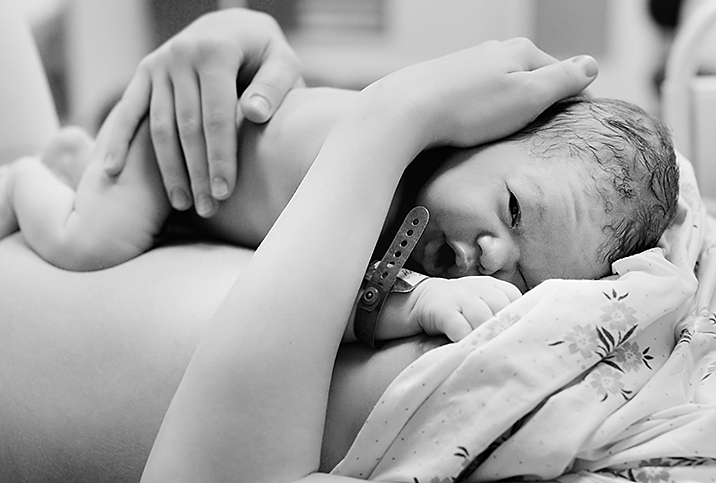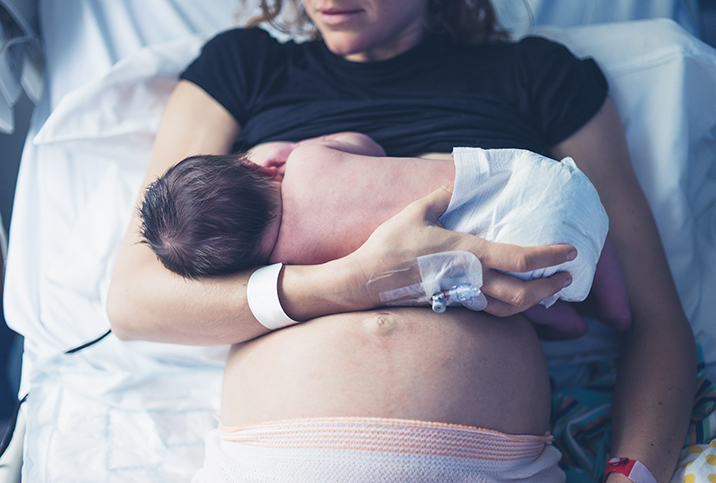Receiving an Epidural May Reduce the Risk of Complications by 35 Percent

Key Points
- Epidurals are the most common and effective means to deliver pain relief during labor.
- A new study suggests receiving an epidural may also decrease the risk of severe complications.
- People with risk factors such as obesity or premature labor may benefit the most from an epidural catheter, according to the research.
Epidurals have been a crucial tool for pain management during labor for more than a century.
Researchers found the use of epidural analgesics decreases a woman's risk of serious complications including heart attack, sepsis and hysterectomy, in the first few weeks after giving birth.
How is epidural analgesia a viable protective option for at-risk pregnancies?
The 2024 study published by the BMJ—the medical journal of the British Medical Association—suggests the epidural could help save lives.
Pregnancy complications raise your risk of death and chronic disease, including heart disease and type 2 diabetes.
For the new study, researchers analyzed data from 567,216 women who gave birth vaginally or via unplanned cesarean section in Scottish hospitals between 2007 and 2019. Out of all patients, about 22 percent had epidural anesthesia.
The data indicated that receiving an epidural during labor and delivery reduced the risk of severe complications by 35 percent.
An epidural involves using a thin, flexible needle to inject an anesthetic or steroid into the fluid sac around the spinal cord, known as the epidural space, according to Cleveland Clinic.
"An epidural provides pain relief during labor by blocking nerve signals in the lower part of the body," said Meleen Chuang, M.D., an OB-GYN and clinical associate professor at Family Health Centers at NYU Langone Health in New York City.
"It is administered through a small catheter placed in the lower back, which delivers a local anesthetic to numb the area and reduce pain sensations. This allows women to have a more comfortable labor experience," Chuang said.
The procedure can also accelerate the delivery of further anesthetics in emergencies.
Although healthcare providers can recommend epidurals, it's ultimately a woman's choice whether to have one.
"Almost everyone in the United States is offered an epidural for pain management unless you have certain medical conditions that preclude the use of epidurals," said Tiffany Pham, D.O., an OB-GYN in Houston and a medical advisor at Flo, a health app for women.
"These conditions may include certain types of spine injuries or abnormalities of the spinal cord that alter the anatomy of the spine, certain heart conditions, increased pressure inside the brain or conditions that increase the risk of bleeding," Pham said.
The benefits of epidurals were especially pronounced in women who delivered prematurely and those with risk factors such as class III obesity, suggested the study. Researchers think the medication may decrease birthing women's stress and make it easier for healthcare providers to monitor patients and their unborn babies.
"The pain relief provided by the epidural allows women to relax and conserve energy during labor. This may help prevent exhaustion and reduce the strain on the body, potentially decreasing the risk of complications," Chuang said.
"Early epidural may be recommended in some circumstances when trying for a trial of labor after cesarean section. This ensures the safety of mother and baby in case emergency delivery is needed."
Increasing access to epidural analgesia—and educating patients about their labor and birthing options—could help decrease maternal morbidity and mortality, researchers said.
"That women and their partners have control over their treatment during pregnancy, including the use of an epidural during labor, is important," said Deborah Lawlor, professor of epidemiology at the University of Bristol, in a news release.
"It is also important that women who would benefit from an epidural to prevent them becoming seriously ill are provided with easy-to-understand information to help them make an informed decision," Lawlor said.
Recommended
- Giving Money to New Moms Can Boost Baby Brain Activity, Study Says: A monthly stipend can have a big impact on a newborn's development.
- How to Be a Supportive Birth Partner: During labor and delivery, you need a partner who's 100 percent able to support you. Here's how.
- How a Traumatic Birth Can Have Lasting Effects on New Mothers: A difficult delivery can cause PTSD, but healing is possible with the right resources.
Who is at higher risk for severe maternal morbidity?
"Severe maternal morbidity (SMM) can affect any pregnant woman, but certain factors can increase the risk," Chuang said.
These include advanced maternal age, pre-existing medical conditions, such as diabetes or hypertension, multiple pregnancies—twins or triplets—obesity and complications during pregnancy or childbirth.
"The rate of severe maternal morbidity has increased in the U.S. in recent years," Chuang said.
"The reasons for this may include factors such as changes in the population demographics, an increase in the number of high-risk pregnancies, older age at delivery, lack of timely access to healthcare, and gaps in the quality of prenatal and obstetric care being delivered. A lot more research is needed to fully understand the causes of this increase."
Previous research, including studies by the authors of the 2024 report, has found women from marginalized communities, including minority ethnic groups and lower socioeconomic areas, are at higher risk of severe maternal morbidity, according to a news release.
They're also less likely to receive epidurals.
Women from the most socioeconomically deprived areas were 16 percent less likely than those from the most affluent areas to receive an epidural during labor, indicated a 2024 report.
"We found that women from areas of greater socioeconomic disadvantage were substantially less likely to receive an epidural for pain relief during labor," researchers wrote.
"These results were consistent when the analysis was restricted to births occurring within an inner-city environment with uniform access to obstetric and obstetric anesthetic services, or when restricted to only include births in women having their first child."
Black women in the United States are 10 percent less likely to receive epidurals than white women, suggested a 2024 report. In part, researchers explained, this may be because of insufficient prenatal education.
Prevalent epidural myths and misconceptions, including the myth that the procedure can raise the risk of an unplanned cesarean birth or harm the baby, may deter some women from choosing to have one.
Reduced access to epidural analgesia, potentially due to the lack of a 24/7 dedicated obstetric anesthesia staff at certain hospitals, could be another factor, researchers said.
"Social inequity and racism could be significant contributors to racial and ethnic disparities in labor neuraxial analgesia use," said Jean Guglielminotti, M.D., Ph.D., assistant professor of anesthesiology at Columbia University, New York City, and first study author, in a news release.
"Racism—including structural, institutional and interpersonal racism—is suggested as a root cause of racial and ethnic disparities in perinatal care access and utilization in the U.S.," he added.
What effect does an epidural have during labor?
Epidurals given during labor numb the area between the belly button and legs, according to Yale Medicine. It allows birthing women to feel pressure but not pain while remaining awake during labor.
General anesthesia, on the other hand, can induce sleep. Doctors try to avoid the latter since the labor and delivery process requires a pregnant woman's participation, except in the case of a c-section.
"Epidurals can provide adequate pain relief during labor, which can have a positive impact on the mother's experience with labor and delivery," Pham said. "Using an epidural for pain control—in lieu of other medications for pain management—reduces the risk for the baby."
Other medications may cross the placenta and produce adverse effects on the baby during labor and after birth, she added.
Although they're considered very safe for most people, epidurals—like any medical procedure—carry some risks and drawbacks.
"For example, they can limit mobility during labor," Pham said. "And side effects may include a fever and headache."
Some women also experience temporary back pain after an epidural. However, a 2019 study suggests the rate of back pain after labor is about the same in women who've had an epidural versus those who have intravenous anesthetic or no anesthetic.
"There is some data to suggest that epidurals can affect the length of labor, but an additional 15-30 minutes does not appear clinically significant compared to the overall length of labor," she continued.
How long are epidural needles?
"An epidural needle compared to a regular needle is slightly longer, about three to four inches," Chuang said.
About one to two inches of the needle enters the body.
"The length is necessary to reach the epidural space in the spine, where the anesthetic is injected," she said. "Regular anesthetic needles vary in length depending on the specific procedure and depth at which the anesthetic needs to be administered."
The bottom line
Research indicates that receiving an epidural not only relieves pain but may decrease the risk of severe maternal health conditions. Still, it's not for everyone.
It's important to know your rights during labor and delivery and understand your options to make an informed decision. If you have questions or concerns about your pregnancy and birth experience, talk to your healthcare provider.


















